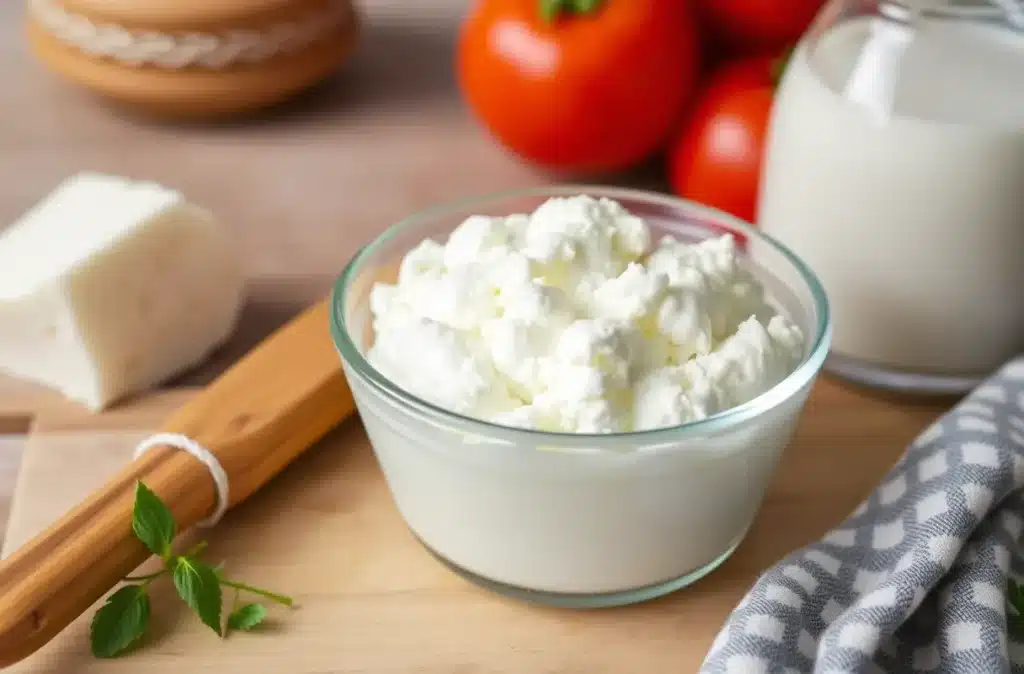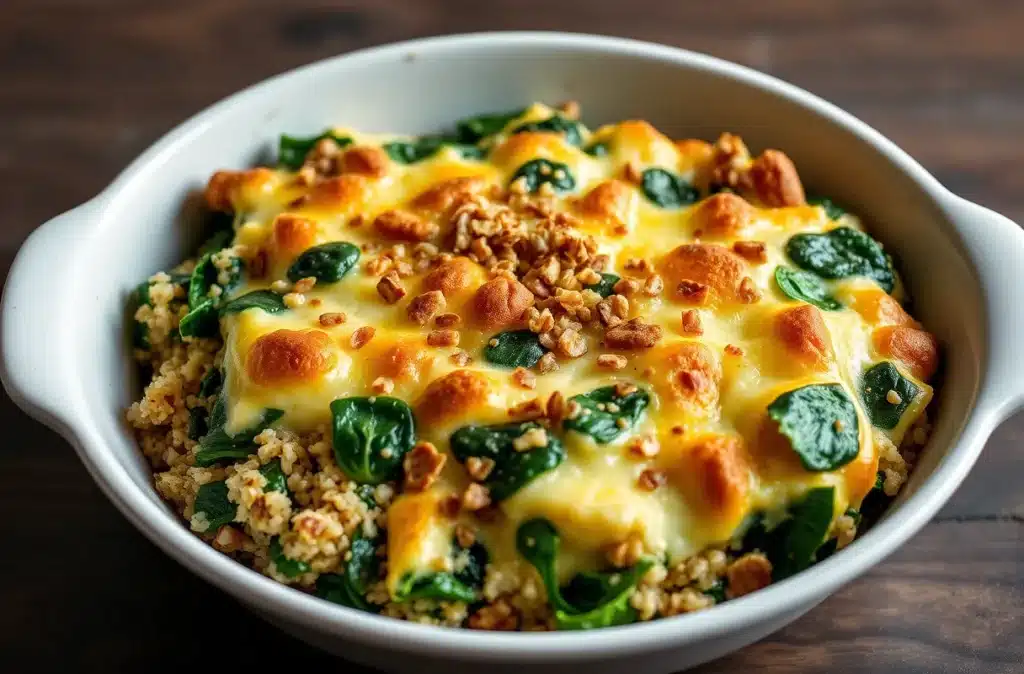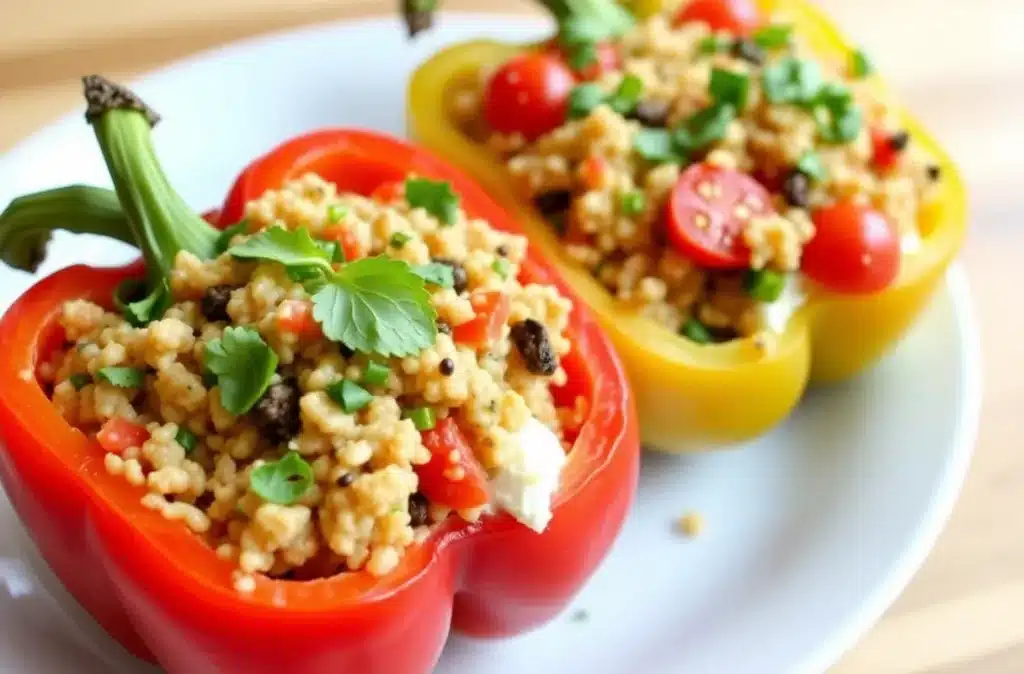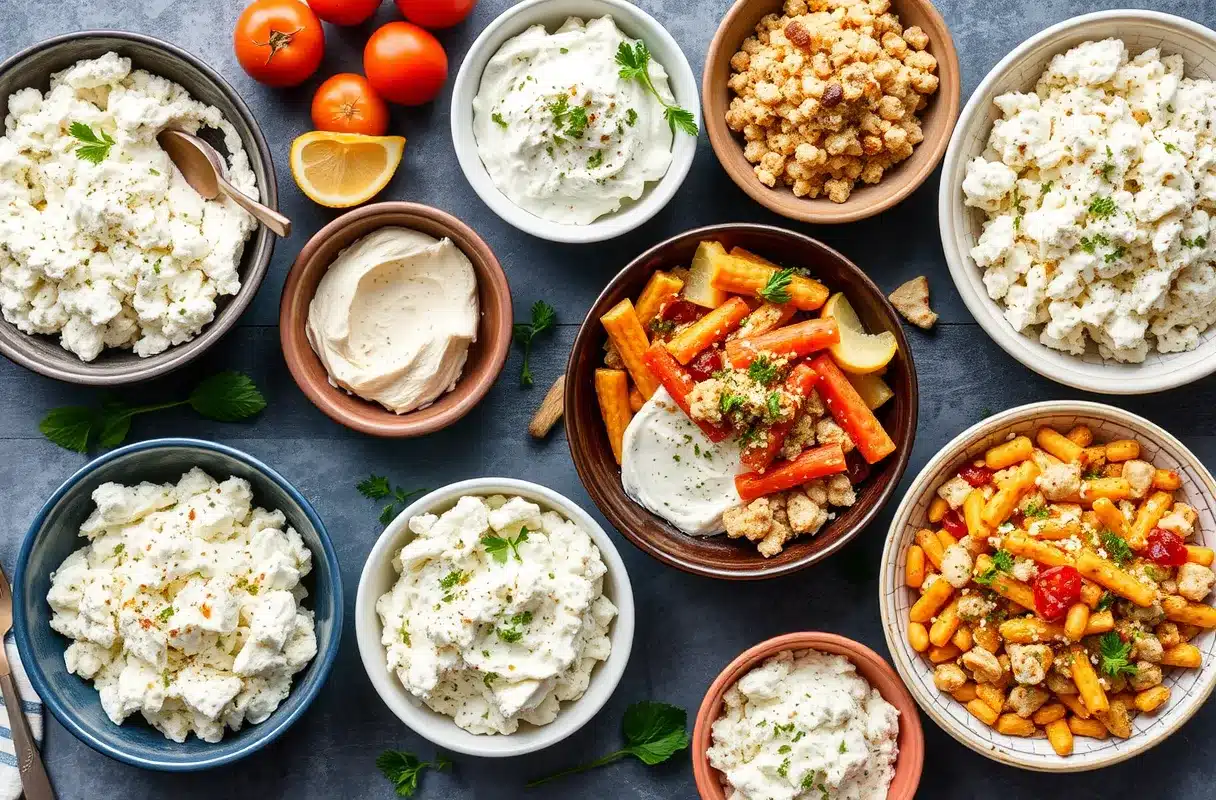Are you wondering how to make cottage cheese recipes from scratch and transform your meals into something extraordinary? Cottage cheese is a versatile, protein-packed ingredient that fits into numerous recipes.
Whether you’re looking for a healthy snack, a filling breakfast, or a satisfying dinner, cottage cheese can do it all.
In this guide, we’ll explore everything from the basics of making cottage cheese to incorporating it into creative recipes.
Let’s dive into the world of cottage cheese and transform your culinary skills!
What Is Cottage Cheese?
Cottage cheese is a fresh cheese known for its mild flavor and creamy texture. Originating centuries ago, it has been a staple in many cultures, prized for its simplicity and nutritional value. It’s made by curdling milk and separating the curds from the whey.
Why Choose Cottage Cheese?
- High in protein: Essential for muscle repair and growth, especially for athletes who need quick recovery after workouts. For dieters, it helps maintain satiety, reducing the urge to snack between meals.
- Low in fat: A healthy alternative to other cheeses.
- Rich in nutrients: Packed with calcium, vitamin B12, and selenium.
- Versatile: Can be used in savory and sweet dishes.
How to Make Cottage Cheese at Home
Ingredients
To make cottage cheese from scratch, you’ll need:
- 1 gallon of whole milk
- 1/4 cup white vinegar or lemon juice
- 1 teaspoon salt (optional)
Step-by-Step Instructions
- Heat the Milk
- Pour the milk into a large pot and heat it over medium heat until it reaches 190°F. Stir frequently to prevent the milk from scalding, as burnt milk can affect the flavor of the cottage cheese. Pour the milk into a large pot and heat it over medium heat until it reaches 190°F.
- Add Acid
- Stir in the vinegar or lemon juice. This will cause the milk to curdle, forming curds and whey.
- Separate Curds and Whey
- Let the mixture sit for 10 minutes. Then, pour it through a cheesecloth-lined strainer.
- Rinse and Salt
- Rinse the curds under cold water to remove any acidity. Add salt for flavor if desired.
- Store
- Transfer the cottage cheese to an airtight container and refrigerate for up to a week.
Tips for Success
- Use fresh, high-quality milk for the best results.
- Adjust the salt to taste after rinsing the curds.
- Experiment with adding herbs or spices to your homemade cottage cheese.

Popular Cottage Cheese Recipes
1. Creamy Cottage Cheese Pancakes
Ingredients:
- 1 cup cottage cheese
- 2 large eggs
- 1/2 cup oat flour
- 1 teaspoon vanilla extract
- 1/2 teaspoon baking powder
Instructions:
- Mix all ingredients in a blender until smooth.
- Heat a non-stick skillet over medium heat.
- Pour 1/4 cup batter onto the skillet and cook until bubbles form. Flip and cook for another minute.
- Serve with fresh fruit or maple syrup.

Nutritional Highlights
- High protein for sustained energy.
- Low in refined sugars.
- Great for a quick breakfast or post-workout snack.
2. Cottage Cheese Veggie Dip
Ingredients:
- 1 cup cottage cheese
- 1/4 cup plain Greek yogurt
- 1 teaspoon garlic powder
- 1 teaspoon onion powder
- Chopped fresh dill (optional)
- Raw veggies for dipping
Instructions:
- Blend cottage cheese and yogurt until creamy.
- Stir in garlic powder, onion powder, and dill.
- Serve with carrot sticks, celery, or bell peppers.
Serving Suggestions
- Use as a sandwich spread.
- Pair with crackers or pita bread for variety.
- Add paprika or chili flakes for a spicy twist.
3. Baked Cottage Cheese Casserole
Ingredients:
- 2 cups cottage cheese
- 1 cup cooked quinoa
- 1 cup chopped spinach
- 2 large eggs
- 1/2 cup shredded cheddar cheese
Instructions:
- Preheat oven to 375°F and grease a baking dish.
- Mix all ingredients in a large bowl.
- Pour the mixture into the dish and bake for 30 minutes.
- Let cool for 5 minutes before serving.

Health Benefits
- Packed with protein and fiber.
- Perfect for meal prep.
- A nutritious and filling main course.
More Creative Cottage Cheese Ideas
4. Cottage Cheese Smoothie Bowl
Ingredients:
- 1/2 cup cottage cheese
- 1 frozen banana
- 1/2 cup mixed berries
- 1 tablespoon almond butter
- Granola and seeds for topping
Instructions:
- Blend cottage cheese, banana, and berries until smooth.
- Pour into a bowl and top with granola and seeds.
5. Stuffed Bell Peppers with Cottage Cheese
Ingredients:
- 4 bell peppers
- 1 cup cottage cheese
- 1/2 cup cooked rice or quinoa
- 1/4 cup diced tomatoes
- 1 teaspoon Italian seasoning
Instructions:
- Preheat oven to 375°F.
- Cut the tops off bell peppers and remove seeds.
- Mix cottage cheese, rice, tomatoes, and seasoning in a bowl.
- Fill peppers with the mixture and bake for 25 minutes.

6. Cottage Cheese Cheesecake
Ingredients:
- 2 cups cottage cheese
- 1/2 cup sugar
- 3 large eggs
- 1 teaspoon vanilla extract
- 1/2 cup graham cracker crumbs (for crust)
- 2 tablespoons butter, melted
Instructions:
- Preheat oven to 350°F.
- Blend cottage cheese, sugar, eggs, and vanilla until smooth.
- Mix graham cracker crumbs with melted butter and press into a baking dish.
- Pour the cottage cheese mixture on top and bake for 30 minutes.
- Cool before serving. Garnish with fresh berries.
- for more recipes Read the Full Article

Health Benefits of Cottage Cheese
1. High-Protein Powerhouse
Cottage cheese contains casein protein, which is digested slowly, keeping you fuller for longer.
2. Weight Management
The low calorie and high protein content make it perfect for weight loss and muscle maintenance.
3. Bone Health
Rich in calcium and phosphorus, cottage cheese supports strong bones and teeth.
4. Digestive Health
Probiotic-rich cottage cheese can help maintain a healthy gut.
5. Versatility for Special Diets
- Keto-Friendly: Low-carb and high-fat properties make it ideal for keto diets.
- Vegetarian: A great source of protein for vegetarians.
- Low-Fat Options: Opt for low-fat cottage cheese to reduce calorie intake.
Creative Storage Ideas for Cottage Cheese
To keep your cottage cheese fresh and flavorful, store it in airtight containers. Adding a layer of parchment paper on top helps prevent moisture buildup.
Avoid placing it near strong-smelling foods in the fridge to maintain its mild flavor.
Exploring Global Uses of Cottage Cheese
Cottage cheese features prominently in global cuisines. In India, it’s used as a base for Paneer-style dishes.
Eastern European recipes incorporate it into dumplings and savory pastries. Try exploring these cultural spins to expand your recipe repertoire.
Cottage Cheese in Desserts
Cottage cheese adds creaminess and a light texture to desserts. Use it to make no-bake cheesecakes, creamy fruit parfaits, or even blended with cocoa powder and honey for a healthy chocolate mousse.
The natural sweetness of the cheese pairs beautifully with fruits and syrups.
Meal Prepping with Cottage Cheese
Incorporate cottage cheese into your weekly meal prep. Use it as a topping for baked sweet potatoes, a mix-in for pasta salads, or a filling for wraps. Its long shelf life makes it a convenient option for busy weeks.
Combining Cottage Cheese with Superfoods
Elevate the nutritional value of your meals by pairing cottage cheese with superfoods like chia seeds, flaxseeds, or avocado. These combinations provide a balance of protein, healthy fats, and fiber, perfect for a post-workout snack or a balanced breakfast.
From healthy breakfasts to indulgent desserts, this versatile ingredient can transform your meals. Follow this guide to master the art of making and using cottage cheese in your recipes today. Happy cooking!
Cottage Cheese for Kids’ Snacks
Cottage cheese is an excellent choice for kids’ snacks. Its creamy texture and mild taste appeal to young palates. Serve it with fresh fruit, use it as a spread on mini sandwiches, or mix it with natural fruit puree for a healthy dip.
Add some fun toppings like colorful sprinkles or mini crackers to make it exciting for kids.
Low-Calorie Substitutions with Cottage Cheese
Cottage cheese is a fantastic low-calorie substitute for various ingredients.
Use it in place of heavy cream in soups or sauces to reduce calories while retaining creaminess. Blend it into smoothies instead of yogurt, or replace ricotta cheese in lasagna for a healthier version without sacrificing taste.
Pairing Cottage Cheese with Seasonal Produce
Leverage seasonal fruits and vegetables to pair with cottage cheese. In summer, combine it with berries and melons for refreshing snacks.
During fall, mix it with pumpkin puree and cinnamon for a cozy treat. Winter favorites include pairing it with roasted squash or citrus fruits, while spring allows for asparagus and radishes to shine.
Cottage Cheese in Savory Breakfasts
Cottage cheese is perfect for savory breakfast options. Spread it on whole-grain toast and top with avocado slices and a sprinkle of chili flakes.
You can also add it to scrambled eggs for a creamy texture or mix it with sautéed vegetables for a protein-packed breakfast bowl.
Cottage Cheese for Skin and Hair Health
Cottage cheese is rich in selenium, zinc, and vitamin B complex, which are vital for healthy skin and hair.
Incorporating it into your diet can improve skin elasticity and promote hair strength. Blend it into smoothies or pair it with antioxidant-rich fruits for a beauty-boosting snack.
Cottage Cheese as a Budget-Friendly Ingredient
Cottage cheese is an affordable source of high-quality protein. It can replace more expensive ingredients like ricotta or cream cheese in recipes.
Use it in dips, spreads, and baked dishes to stretch your grocery budget without compromising flavor or nutrition.
Frequently Asked Questions (FAQs)
1. Is it OK to eat cottage cheese by itself?
Yes, cottage cheese can be enjoyed on its own. Its mild flavor and creamy texture make it a satisfying snack or meal base.
2. What has more protein, eggs or cottage cheese?
Cottage cheese generally has more protein per serving than eggs. A half-cup of cottage cheese provides about 14 grams of protein, while one egg contains around 6 grams.
3. Is cottage cheese anti-inflammatory?
Yes, cottage cheese contains casein protein and other nutrients that may have anti-inflammatory properties, especially when consumed as part of a balanced diet.
4. How many times a week should you eat cottage cheese?
You can safely eat cottage cheese 3-4 times a week, depending on your dietary needs and preferences. It’s a versatile and nutrient-rich food.
5. Which is healthier: 2% or 4% cottage cheese?
2% cottage cheese is lower in fat and calories, making it a better choice for weight management. However, 4% cottage cheese provides a richer texture and taste.
6. Is 2 eggs a day enough protein?
Two eggs provide about 12 grams of protein, which may be sufficient for a light meal or snack. For higher protein needs, pair eggs with other protein-rich foods like cottage cheese.
7. What is the healthiest protein to eat?
The healthiest protein sources include lean meats, fish, legumes, and dairy products like cottage cheese. These foods provide essential nutrients with minimal saturated fat.
Conclusion
Learning how to make cottage cheese recipes opens up a world of culinary possibilities. From healthy breakfasts to indulgent desserts, this versatile ingredient can transform your meals. Follow this guide to master the art of making and using cottage cheese in your recipes today. Happy cooking!



